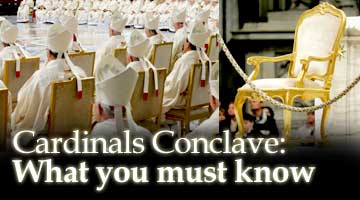
The Conclave of Cardinals to elect the successor to Pope John Paul II begins on Monday with a Votive Mass at St Peter's Basilica at the Vatican.
How is the conclave held?
A ready reckoner on the conclave that will elect the 265th Pope this week.
Who elects the new Pope?
115 cardinals from 52 countries representing Asia, Africa, Europe, Australia, Latin America and North America have the voting rights to elect the next Pope.Are there only 115 cardinals in the Roman Catholic Church?
No, 122 cardinals attended the general congregation of cardinals at the Vatican last week after Pope John Paul II's funeral. But Vatican rules stipulate that only cardinals younger than 80 before John Paul II's death have the voting rights.How does the conclave begin?
It begins with a Mass for the election of the Holy See that will be celebrated in the Vatican Basilica. At 4:30 pm local time (2100 IST) on April 18, the procession of cardinal electors will leave the Hall of Blessings for the Sistine Chapel. Once in the Chapel, all the cardinal electors will swear the oath. The cardinal dean will read the formula of the oath, after which each cardinal, stating his name and placing his hand on the Gospel, will pronounce the words: 'I promise, pledge and swear.' The cardinals then also take another oath: -- 'Whichever of us by divine disposition is elected Roman Pontiff will commit himself faithfully to carrying out the Munus Petrinum (office of St Peter, the first Pope) of the Pastor of the Universal Church.'Who is the cardinal dean?
Cardinal Joseph Ratzinger, a German who is the Dean of the College of Cardinals, presides over the conclave.Where do the cardinals stay during the conclave?
The cardinals will stay throughout the conclave in the new Domus Sanctae Marthae, a residence far more comfortable than the former Apostolic Palace cells. They will vote in the Sistine Chapel.Who will provide support for the conclave?
The conclave will have a support staff (seven aides, two physicians, priests to hear confessions, cooks, housekeepers), also sworn to 'observe absolute and perpetual secrecy' about all matters regarding the election. Two technicians will check the hall to prevent recording or transmission devices.What is the schedule for the conclave?
During the conclave, the cardinals will have the following timetable: At 7:30 am, the celebration or concelebration of Mass will take place in the Domus Sanctae Marthae. By 9 am, they will be in the Sistine Chapel. There they will recite the Lauds of the Liturgy of the Hours. Immediately afterward, voting will take place according to the prescribed ritual -- two votes in the morning, and two votes in the afternoon.In the afternoon, voting will begin at 4 pm. At the end of the second vote will be vespers (prayers).
What happens after the voting?
After the two votes of the morning and the two of the afternoon, respectively, the ballots and any notes the cardinals have made will be burnt in a stove located inside the Sistine Chapel. If no decision has been reached, the paper will be burnt the way they are, so that the smoke is black. If a new pope has been elected, chemicals will be added to the paper, so that the smoke is white. The smoke could appear at around noon and at about 7 pm -- unless the new Pope is elected either in the first vote of the morning or the first vote of the afternoon, in which case the smoke will emerge earlier. Along with the white smoke, the bells of St Peter's will peal to mark a successful election.What happens if no cardinal gets a majority?
The valid quorum for electing the Pope is initially two thirds. After three days of voting without an election, there will be a day dedicated to reflection and prayer, without voting. Thereafter, voting will resume for seven additional ballots, another pause for reflection, another seven ballots, another pause and yet another seven ballots. After which an absolute majority will decide how to proceed, that is, for either a vote by absolute majority or with balloting between two candidates. This will happen only in the event that the cardinals arrive at the 33rd or 34th ballot without a positive result.How is the winner announced?
When a winner emerges after probably several rounds of voting, he is formally asked to announce his new papal name. The cardinal electors then make an act of homage to their new pontiff.The new pope then appears in the balcony of St Peter's Basilica and blesses the thousands of pilgrims amassed there.
Photographs: THOMAS COEX/AFP/Getty Images
Image: Rahil Shaikh





